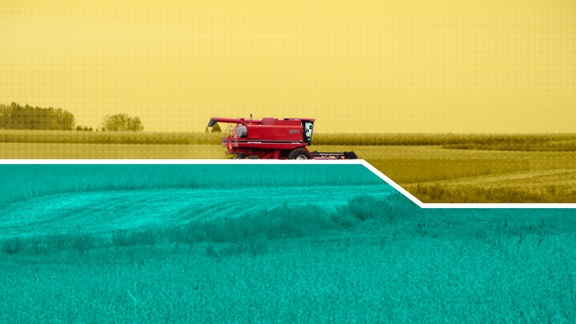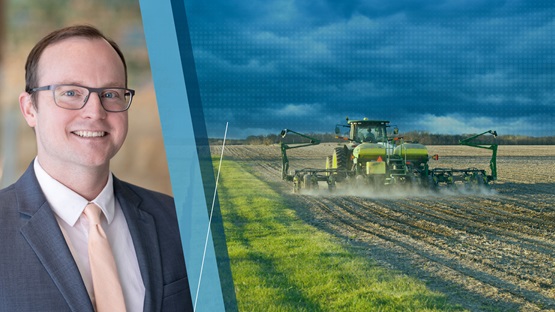Farmers always have a lot riding on harvests. But heading into this year’s fall harvest, they were also contending with lower incomes, due to falling output prices and high production costs. That’s according to a third-quarter survey of agricultural bankers by the Federal Reserve Bank of Minneapolis.
“Commodity prices are trending down, interest rates are high, moisture is good,” commented a South Dakota banker on the survey, which was conducted in October and asked respondents about conditions over the months from July through September. Spending on capital equipment also fell, though farm household purchases increased on balance. Loan demand and the rate of loan repayment were nearly unchanged, and loan renewals and extensions largely held steady. Land values and cash rents increased from a year earlier across district states, even as interest rates on loans continued to increase substantially. The outlook for the fourth quarter is modestly pessimistic, with most lenders in the district expecting farm incomes to decrease.
Farm income, household spending, and capital investment
Though incomes fell on balance, the decline was not uniform. Districtwide, 46 percent of agricultural lenders surveyed said incomes decreased in the third quarter from a year earlier, up from 35 percent the prior quarter (see chart). More than a third of respondents indicated that spending by farm households increased, while slightly more than half reported no change. Capital spending also dropped: 35 percent of respondents reported decreased investment in equipment and buildings from a year ago, compared with 21 percent who reported increased spending. “Interest rates are slowing down borrowing and capital purchases as cash flows are under more stress,” reported a Minnesota banker.
Loan repayments and renewals
Farm finances remained in good condition despite the negative hit to incomes. The rate of repayment on agricultural loans and loan renewals largely held steady, though both increased on balance. Loan repayments were unchanged from a year earlier according to 83 percent of respondents, and the same share reported that renewals or extensions were unchanged. Meanwhile, 12 percent reported that repayment rates increased and 13 percent said renewals increased. Only 4 percent of bankers reported having refused a loan due to a shortage of funds.
Demand for loans, required collateral, and interest rates
Demand for loans hardly changed on balance from the low level prevailing over the past several years, according to lenders, as 52 percent reported no change to loan demand relative to a year ago. By contrast, 25 percent noted greater loan demand, and 23 percent said it was lower. Collateral requirements on loans were also unchanged according to 85 percent of lenders surveyed, though the remainder reported increases in collateral requirements. Interest rates continued to increase, climbing at least 20 basis points for all loan categories in the survey.
Cash rents and land values
Land values and cash rents continued to climb in the third quarter following a period of several years of strong growth. Ninth District nonirrigated cropland values increased by 7.2 percent on average from the third quarter of 2022. Values for irrigated land increased by 12.8 percent, while ranchland and pastureland values increased almost 2.1 percent. Several respondents noted pressures behind rising farmland prices, such as out-of-state hunters looking for recreational land as well as domestic and international investors purchasing property. These pressures have “driven up the price of ag land making next to impossible for the next generation to purchase or even lease land to farm or raise livestock,” said a Montana banker. “More & more is taken out of production as well.”
Land rents followed suit, as the district average cash rent for nonirrigated land increased by 4.2 percent from a year ago. Rents for irrigated land grew by 8 percent, while ranchland rents jumped 10.9 percent.
Outlook
Bankers’ outlooks for agriculture over the remainder of 2023 are generally pessimistic. Across the district, 60 percent of bankers expect that farm incomes will decrease in the fourth quarter, compared with 17 percent who expect increased incomes. The outlook for farm capital spending is also contractionary, while lenders expect household spending to flatten. More than a third of lenders expect loan demand to increase despite higher interest rates, likely as a result of the tightening cash positions of agricultural producers. However, most lenders—71 percent—don’t anticipate any change in loan repayment rates, and more than three-quarters expect no change in renewals and extensions.
| MN | MT | ND | SD | WI | Ninth District | |
|---|---|---|---|---|---|---|
| Percent of respondents who reported decreased levels for the past three months compared with the same period last year: | ||||||
| Rate of loan repayments | 14 | – | – | 20 | – | 6 |
| Net farm income | 55 | – | 40 | 40 | 67 | 46 |
| Farm household spending | 5 | – | 30 | 7 | 33 | 12 |
| Farm capital spending | 36 | – | 50 | 27 | 33 | 35 |
| Loan demand | 27 | – | 20 | 20 | 67 | 23 |
| Percent of respondents who reported increased levels for the past three months compared with the same period last year: | ||||||
| Loan renewals or extensions | 5 | 50 | 30 | 7 | 33 | 13 |
| Referrals to other lenders | 9 | 50 | – | – | – | 6 |
| Amount of collateral required | 5 | – | – | 13 | – | 15 |
| Loan demand | 27 | – | 30 | 13 | – | 25 |
| MN | MT | ND | SD | WI | Ninth District | |
|---|---|---|---|---|---|---|
| Percent of respondents who expect decreased levels for the next three months: | ||||||
| Rate of loan repayments | 18 | – | 20 | – | 33 | 13 |
| Net farm income | 82 | – | 50 | 33 | 100 | 58 |
| Farm household spending | 23 | – | 20 | 13 | 33 | 17 |
| Farm capital spending | 68 | – | 40 | 33 | 100 | 44 |
| Loan demand | 27 | 50 | 30 | 33 | – | 29 |
| Percent of respondents who expect increased levels for the next three months: | ||||||
| Loan renewals or extensions | 14 | – | 30 | 7 | 67 | 17 |
| Referrals to other lenders | 9 | 50 | – | – | – | 6 |
| Amount of collateral required | – | – | 40 | 13 | – | 12 |
| Loan demand | 45 | – | 20 | 33 | 100 | 38 |
| Operating | Machinery | Real estate | |||||
|---|---|---|---|---|---|---|---|
| Fixed | Var. | Fixed | Var. | Fixed | Var. | ||
| Q4-21 | January | 4.7 | 4.4 | 4.5 | 4.3 | 4.3 | 4.1 |
| Q1-22 | April | 4.7 | 4.6 | 4.7 | 4.5 | 4.5 | 4.3 |
| Q2-22 | July | 5.5 | 5.4 | 5.5 | 5.3 | 5.4 | 5.1 |
| Q3-22 | October | 6.5 | 6.3 | 6.2 | 6.1 | 5.9 | 5.8 |
| Q4-22 | January | 7.7 | 7.6 | 7.3 | 7.3 | 7.0 | 7.0 |
| Q1-23 | April | 8.1 | 8.0 | 7.6 | 7.6 | 7.3 | 7.4 |
| Q2-23 | July | 8.5 | 8.5 | 7.9 | 8.0 | 7.5 | 7.5 |
| Q3-23 | October | 8.8 | 8.7 | 8.3 | 8.2 | 7.9 | 7.9 |
Joe Mahon is a Minneapolis Fed regional outreach director. Joe’s primary responsibilities involve tracking several sectors of the Ninth District economy, including agriculture, manufacturing, energy, and mining.





